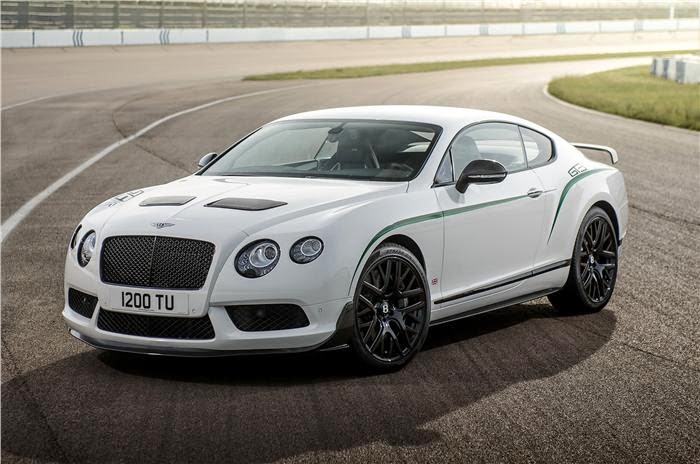Bentley reveals Continental GT3-R prior to Goodwood debut.
The new Bentley Continental GT3-R has been revealed, the “fastest-ever accelerating” and “most dynamic road car” in its history, as the British marque seeks to refocus its brand image as offering “performance-focused luxury”. Just 300 examples of the model - which, the company says, was directly inspired by the Bentley GT3 race car - will be built at a price yet to be announced.
The new GT3-R is based on the Continental. It is a strict two-seater and powered by a newly retuned version of the familiar 4.0-litre twin-turbo V8 engine. This now delivers 572bhp and 71.4kgm of torque from just 1700rpm. The GT3-R also weighs 100kg less than a GT V8 S. The engine is hooked up to an eight-speed ZF automatic gearbox, which has shorter gearing than in other Continental GT models. Bentley claims that the GT3-R will accelerate from zero to 100kph in just 3.6sec. The engine’s exhaust system is all new and made from titanium, saving 7kg, and has been acoustically tuned to deliver a “unique baritone roar”. The revamped powertrain, which also gets modified electronic stability control, drives through a new version of the Continental’s all-wheel drive system. It is now fitted with torque vectoring for the first time. The system allows the engine’s huge torque output to be split unequally between the rear wheels. This enables the car to turn in to bends more aggressively and should dramatically reduce understeer - important in a car that has its engine mounted ahead of the front axle.
The car’s Drive and Sport modes are now said to be more clearly defined from each other, with the Sport mode “designed for more spirited driving”. The operation of the column-mounted gearshift paddles has also been recalibrated. Bentley says the result is “the most dynamic, responsive and involving Bentley road car ever”. The GT3-R rides on the same basic suspension, but the air springs and dampers have been further developed from the set-up used on the Continental GT V8 S.
The new car has 21-inch forged wheels. The braking system uses Bentley’s familiar carbon-silicon-carbide braking system, with 420mm discs and eight-piston calipers at the front and 365mm discs at the rear. Bentley says that such is the power of this braking system that it can absorb up to “10 megajoules” of energy in one stop, which would be “enough to power a family home for six hours”.
Rolf Frech, Bentley board member for engineering, said the firm wanted to push the Continental’s powertrain and chassis further than ever with a “torque vectoring system that neutralises understeer and a chassis tune that is both direct and forgiving”. Frech said, “We’ve differentiated the Drive and Sport modes to further give the driver a choice between a relaxed grand tourer and a sharp supercar with instant responses thanks to new turbochargers that eliminate turbo lag. Dynamically, the GT3-R is our finest hour yet.”
Dramatic changes have also been wrought both outside and inside the car. The GT3-R is now a strict two-seater, the rear seats replaced by a luggage bench. The front sports seats are a new design, with larger side bolsters, new foam cores and trim that features Beluga black leather and diamond-quilted Alcantara. The same material combination appears on the steering wheel and shifter. Carbonfibre is used for the centre console, fascia panels and door casings. GT3-R badging is fitted to the centre console, passenger-side fascia and sill tread plates.
On the outside, the GT3-R is distinguished by a new front splitter and rear spoiler made from carbonfibre, and two new bonnet vents. All 300 cars will be finished in Glacier White paint and all the headlamp bezels, radiator shell, matrix grille and window surrounds are gloss black. The two-tone green graphics are described as tracing the “the power lines” on the side profile of the car.
Wolfgang Dürheimer, Bentley’s newly installed boss (who is now in his second spell at the head of the company) said the GT3-R “had to be the most luxurious track-inspired grand tourer ever… this car pushes our trademark combination of luxury and performance to a new level.” The talk of performance-focused luxury by Bentley is a prelude to the new-generation models arriving over the next few years. Aside from the new SUV, which is the first new-generation model, the replacement for the Continental and Flying Spur models will be based on an all-new platform called MSB.
The MSB platform is, in effect, the next-generation version of the architecture that underpins the Porsche Panamera. The vital difference between this platform and what Bentley uses today is that it is natively rear-wheel drive. That is to say, the engine is longitudinally mounted and sits well back in the engine bay, sending power primarily to the rear wheels (although, obviously, all-wheel drive will be an option).
Today’s Continental and Flying Spur platform is related to the Volkswagen Phaeton and Audi A8, both of which have a longitudinally mounted engine that sits ahead of the front axle. This nose-heavy stance makes tuning a car for ultimate performance driving very hard, although Bentley has been surprisingly successful in this respect, aided by a rear-biased four-wheel drive system. The torque vectoring on this new model will further help, but when Bentley shifts to the new MSB platform from 2017, the near-ideal weight distribution and much-improved steering layout and geometry will finally allow the brand to build really serious performance-led cars.
The GT3-R is a clear signal to expect a change in the Bentley brand and its approach. ‘Performance-focused luxury’ is a tag that doesn’t just apply to the GT3-R; it also signposts the way Bentley will change in the second half of this decade.




Comments
Post a Comment